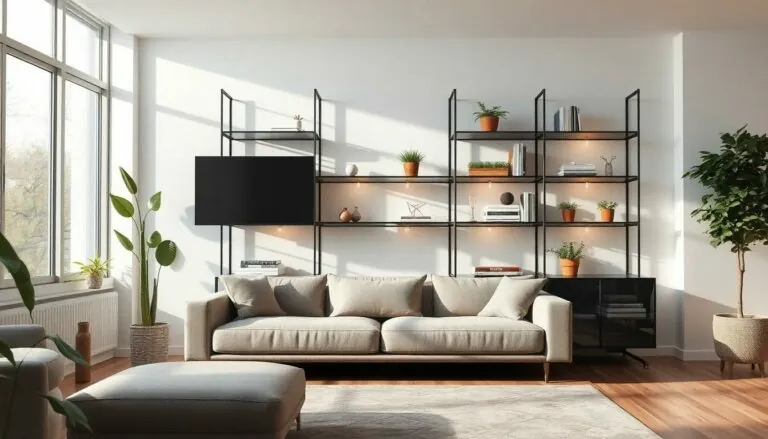Transitional living rooms are like the chameleons of home design, effortlessly blending modern flair with timeless elegance. Imagine a space where sleek lines meet cozy textures, creating an inviting atmosphere that says, “Come on in, let’s binge-watch our favorite series while sipping artisanal coffee.” It’s the perfect balance between style and comfort, making it the go-to choice for those who want their home to feel both chic and lived-in.
In a world where trends come and go faster than a TikTok dance, transitional living rooms stand the test of time. They embrace versatility, allowing homeowners to mix and match styles without looking like they just raided a garage sale. So if you’re ready to transform your space into a stylish sanctuary that’s as functional as it is fabulous, buckle up! This journey through transitional living rooms is about to get exciting.
Table of Contents
ToggleOverview of Transitional Living Rooms
Transitional living rooms seamlessly blend modern and traditional design elements, creating inviting spaces that exude elegance. Elements of comfort and style define these areas, resulting in an ambiance that invites relaxation. Homeowners appreciate the versatility of transitional living rooms, which allow for a harmonious mix of various furnishings.
Color choices tend toward neutral tones. Soft whites, grays, and warm beiges serve as a backdrop, while bolder accents add character. Popular accents include earthy greens and deep blues. Fabrics used in transitional spaces often combine textures, such as linen, leather, and velvet, enhancing visual interest and sensory appeal.
Furniture selections play a crucial role in establishing a transitional aesthetic. Clean lines characterize sofas and chairs, often incorporating inviting cushions. Coffee tables also display sleek designs, frequently crafted from wood or metal. Accessories complement the overall look, with artwork and decor items adding personal touches.
Lighting fixtures contribute significantly to the atmosphere of transitional living rooms. Stylish chandeliers or pendant lights serve as focal points while providing warmth. Layered lighting, incorporating floor lamps and table lamps, further enriches the space.
Finally, the arrangement of furniture promotes conversation and interaction, essential elements in transitional living rooms. Placing seating around a central point encourages connection, creating a space where family and friends can gather comfortably.
Key Features of Transitional Living Rooms
Transitional living rooms blend modern aesthetics with classic charm, creating elegant spaces. Several key features define these versatile environments.
Color Palette
Neutral color palettes are widely used in transitional living rooms. Soft whites, soothing grays, and warm beiges create a calming atmosphere. Homeowners often incorporate bolder accent colors, such as earthy greens and deep blues, to add visual interest. These colors evoke a sense of balance, making the room inviting yet sophisticated. The right mix of hues enhances the space’s overall appeal while maintaining a timeless elegance.
Furniture Selection
Furniture selection plays a crucial role in transitional living rooms. Clean-lined sofas and chairs serve as foundations for comfort and style. Inviting cushions add texture and warmth, making the seating areas welcoming. Sleek coffee tables, crafted from wood or metal, contrast with softer elements, creating visual harmony. Each piece contributes to the room’s functionality and aesthetic, encouraging meaningful conversations and connections among family and friends.
Designing a Transitional Living Room
Creating a transitional living room involves carefully considering both layout and lighting. These elements play crucial roles in establishing a cohesive and inviting space.
Layout Considerations
Space planning remains essential for a functional transitional living room. If arranging furniture thoughtfully, ensure pathways remain clear for easy movement. Placing the sofa at the room’s focal point encourages conversation, while using additional seating options fosters inclusivity. Embracing various furniture heights adds visual interest. Additionally, integrating a mix of textures in rugs and throws enriches the comfort level and aesthetic appeal.
Lighting Choices
Selecting the right lighting enhances the ambiance of a transitional living room. Choosing layered lighting allows for flexibility in mood settings. A central chandelier provides a stylish focal point, while floor lamps and table lamps create warmth and intimacy. Incorporating dimmer switches can adjust brightness levels, accommodating different activities. Utilizing natural light through well-placed windows or sheer curtains further brightens the space, enhancing its openness and inviting atmosphere.
Popular Trends in Transitional Living Rooms
Neutral color palettes remain a staple in transitional living rooms. Soft whites, grays, and warm beiges dominate the design, creating a serene backdrop for bolder accent colors. Earthy greens and deep blues enhance the overall visual appeal, adding depth and balance to the ambiance.
Furniture selection plays a crucial role in establishing the transitional style. Clean-lined sofas and chairs ensure a modern aesthetic while inviting cushions offer comfort. Choosing coffee tables with wood or metal finishes adds a touch of elegance without compromising functionality.
Layered lighting is essential for creating a warm and inviting atmosphere. A stylish chandelier serves as a focal point in the room and additional lamps provide ambient glow. Including dimmer switches allows for flexibility, adjusting brightness based on the occasion.
Furniture arrangement influences interaction and flow. Clear pathways between seating encourage conversation, making the space ideal for gatherings. Mixing various furniture heights and textures enriches the aesthetic, contributing to a dynamic visual experience.
Finally, integrating natural light through large windows or sheer curtains enhances openness. Bright, airy environments promote a welcoming atmosphere, inspiring relaxation. Homeowners prioritize these design elements to cultivate a cozy yet chic vibe, ensuring transitional living rooms remain timeless and functional.
Benefits of Transitional Living Rooms
Transitional living rooms offer a blend of comfort and elegance, creating inviting spaces ideal for relaxation and gatherings. Such environments enhance aesthetic appeal by combining modern and traditional elements, providing versatility in design.
Neutral color palettes like soft whites, grays, and warm beiges promote a sense of tranquility, while bolder accents in earthy greens and deep blues add character. These color choices evoke balance, making the transition between styles seamless and pleasing to the eye.
Furniture selection plays a crucial role in achieving the desired style. Clean-lined sofas and chairs provide comfort, while inviting cushions and sleek coffee tables enhance functionality. This thoughtful arrangement encourages meaningful conversations, making these spaces conducive to social interactions.
Layered lighting significantly impacts the ambiance. Stylish chandeliers and strategically placed lamps create a warm, inviting glow. The combination of different light sources adds depth, allowing homeowners to adjust the mood as needed.
Furniture arrangement is key in transitional living rooms. A well-structured layout promotes easy movement, ensuring clear pathways for conversation. Mixing various furniture heights and textures enriches the overall aesthetic, making the space feel dynamic and engaging.
Natural light also enhances the atmosphere. Large windows and sheer curtains invite sunlight, creating an open and welcoming environment. This connection to the outdoors contributes to the overall uplifting feeling within transitional living rooms.
Transitional living rooms stand out as a perfect fusion of modernity and tradition. Their inviting nature creates a warm environment where comfort meets style. By thoughtfully selecting colors furniture and lighting, homeowners can craft spaces that not only look good but also encourage connection and relaxation.
The versatility of these rooms allows for personalization while maintaining a cohesive aesthetic. With the right arrangement and design elements in place these living spaces become functional sanctuaries that cater to both everyday life and special gatherings. Embracing the transitional style opens the door to endless possibilities in home design.




